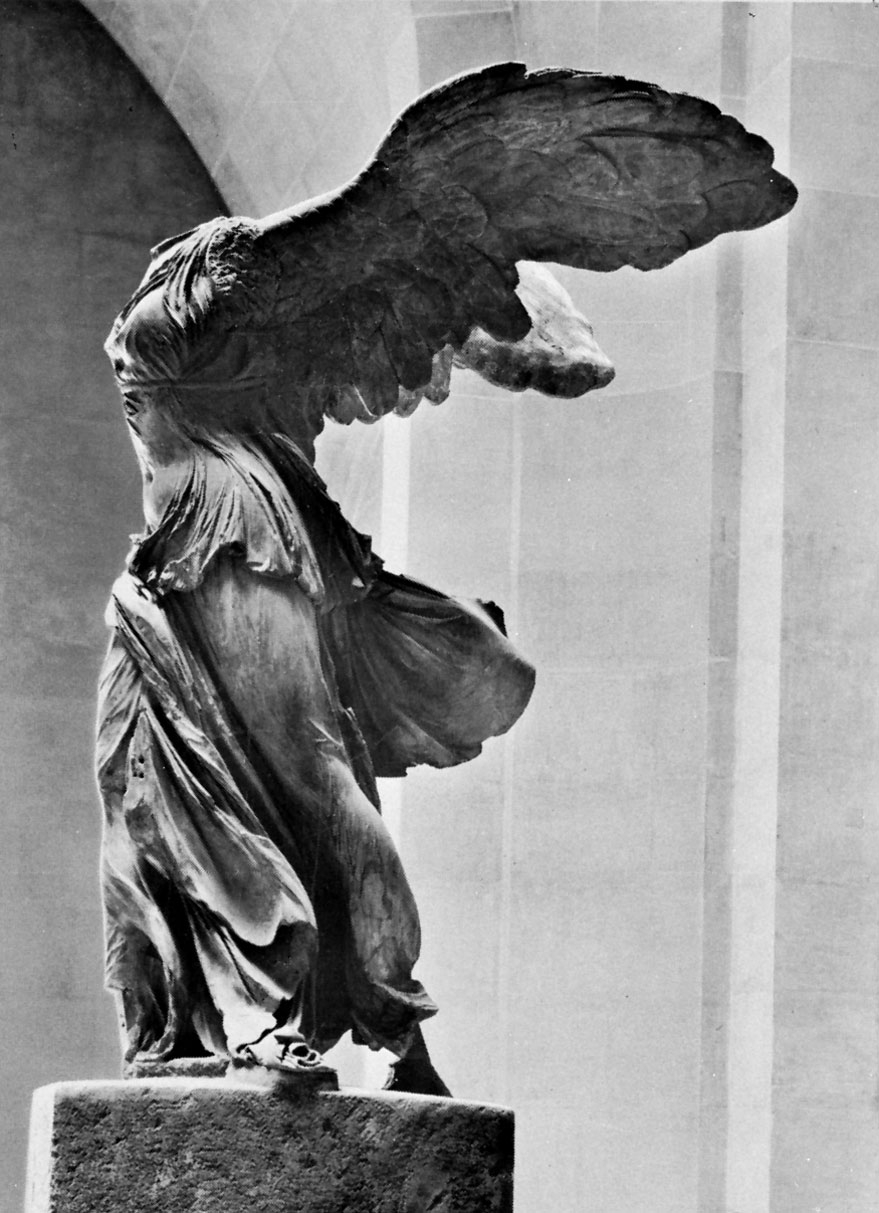Nike Free
by William Robert
I run in Nike Free, divinely inspired running shoes. In them I am, I am able to be, spiritual.
Nike (Νικη) names an ancient Greek goddess or spirit, a divine courier who delivers Zeus victoriously via his chariot. She is a winged intermediary, moving and transporting through the air between here and there, between mortal and divine. The daughter of a titan and a river, she is a force of nature, a numinous being, a kind of angel, who bears deep bonds to Athena, goddess of wisdom. In Nike, wisdom is related to movement, transit, and to air.
Nike moves unencumbered—which is to say, freely. In many ways, then, Nike Free is redundant, particularly when Free suggests not, or not only, an enlightened free agent who is “free to” but a bareness that is “free from” unnecessary embellishment. In running shoes, such freedom often translates into a modern fetishization of technology, of progress (new = better) and excess (more = better). Nike Free running shoes, however, resist this fetish, opting for a different equation: new = less, and that less = better. These shoes promise freedom by using technology to strip away as much encumbering technics as possible. Introduced in 2005, Nike Free got back to basics and hence to the elements, coming two steps away from being barefoot (thanks to their extremely thin and flexible sole). Running in them, unlike running in almost any other kind of running shoes, my feet feel the ground’s contours, its textures and striae.
Running in them, I become more bodily, more aware of my bodily movements, since I can feel those kinetic effects in my feet as they contact a solid surface and then lift themselves into air: contact, release, contact, release; earth, air, earth, air. Unlike nearly all other running shoes, Nike Free do not overcushion and overcorrect. They do not permit bad technique or incorrect form. Instead, they insist on corporeal sensitivity, reconnecting my bodily parts to one another by reminding me of action-reaction relations. They silently suggest kinesthetic corrections, modifications in motion. They, like other spiritual exercises, are praxial rather than simply practical: they are transformative, perhaps even transfiguring.
Running in them, I am my most bodily, hyperaware of my bending knees and elbows, of my foot stride and impact, of the angles of my head and chest, of my heart and lungs as they invigoratingly move air, resuscitating—almost resurrecting—my sense of my corporeality. Running in them, I move and move through air. Thus I am, in a seeming paradox, simultaneously my most spiritual and my most bodily, most spiritual because most bodily. This seeming paradox exposes itself as illusory as I re-member spirit: a matter of breath, of air. Spirit—as ruach, as psuchē or pneuma, as anima or spiritus—names breath, wind, air with movement. It is elemental, sensible, mobile, dynamic, animating, vital and vitalizing. It is divine, as Nike’s domain or as ruach elohim (a Hebrew name of god), as well as human, even fundamentally so in tripartite anthropologies, including Stoic and Pauline, that conceive of humanity as body, soul, and spirit. Spirit, as a matter of breath—as the (literal or figurative, biological or religious) breath of life—is humanly necessary, and that necessity ties spirituality to corporeality, bound together by air. My body cannot live for long without air, without respiring.
Running makes me acutely aware of that need; it makes me intensely sensitive to my breathing—that is, my relationship with air. Running is all about breath, air, spirit, since it involves respiration, perspiration, and, for me, inspiration. When I run, and my body is continually in motion, moving and moving me from here to there like Nike in transit, I am most receptive to inspiration, to thoughts and perceptions that I take in like air. I am, body and soul (however those words signify), my most porous, and I do my best thinking and my best contemplating while running. I, like my stripped-down shoes, feel less encumbered, more flexible, most free. Respiration and inspiration meld as body and spirit mingle.
I breathe in air rhythmically, and with it comes…well, that depends. Sometimes while running I work through intellectual puzzles. Sometimes I ponder personal predicaments. Occasionally I stumble upon wisdom (recalling Nike’s relation to Athena). Sometimes I experience an airy stream of conscious perception. Sometimes I am simply free, free from distracting concerns or laborious thoughts or conscious monologue—free, that is, from a certain reflexive self, in an experiential zone (sometimes dubbed simply “the zone”) to which many spiritual or religious praxes aspire. Running can inspire or even be what others label meditation, moksha, prayer, contemplation, communion, ecstasy, enlightenment.
My Nike Free are akin to an athletic sajjāda or tallith or prayer beads (whether japamala or rosary or otherwise): they become the medium, the apparatus, the tool or supplement, that enable my running, which engenders what I experience as and am calling spirituality. If I am spiritual, I am so while running, sensitively breathing in the world.
